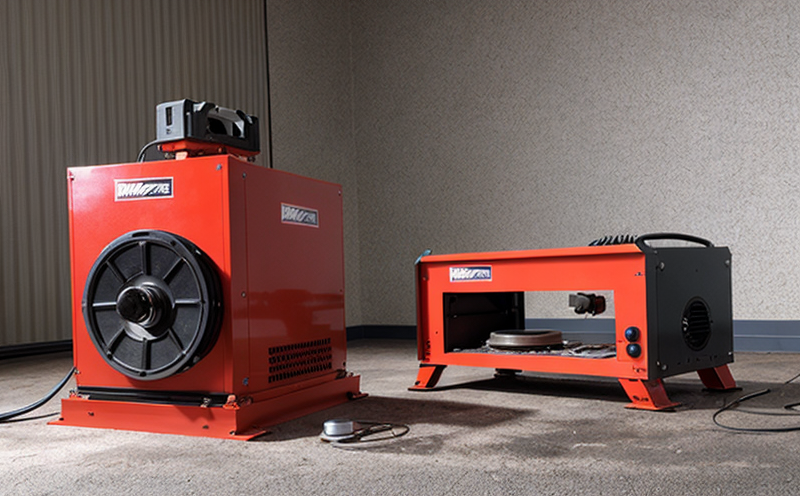MIL-STD-810H Shock Testing for Defense Equipment
The Military Standard MIL-STD-810H is a comprehensive set of environmental engineering tests and methods designed to qualify equipment for military use. It encompasses various types of shock testing aimed at assessing the durability, resilience, and reliability of defense equipment under extreme conditions. This standard ensures that products meet stringent requirements before deployment in harsh environments.
Shock testing, specifically covered under MIL-STD-810H Method 516.7, evaluates how well a product can withstand sudden changes in velocity or force—commonly referred to as shock or impact events. These tests are critical for defense equipment because they may encounter severe shocks during transport, handling, and operational use.
The testing process involves subjecting the specimen to controlled shock pulses using specialized test machines such as drop towers or pendulum hammer testers. The goal is to simulate real-world conditions that could cause damage or failure in the product's performance. Compliance with MIL-STD-810H ensures that equipment can endure these challenges without compromising its functionality.
Compliance officers and quality managers rely on this testing method to ensure regulatory adherence while R&D engineers benefit from understanding potential weaknesses early in development stages. By incorporating MIL-STD-810H shock testing into their processes, manufacturers enhance product robustness and reliability, thereby increasing customer satisfaction and reducing warranty claims.
Defense equipment subjected to MIL-STD-810H testing includes various components like electronics enclosures, weapon systems, communications gear, and vehicles. The standard's rigorous requirements guarantee that these items can withstand the rigors of deployment without failure.
In summary, MIL-STD-810H shock testing serves as a vital tool for quality assurance in defense equipment manufacturing. Its comprehensive approach ensures that products are robust enough to meet both current and future operational demands. By adhering to this standard, manufacturers can provide reliable solutions capable of withstanding the most challenging conditions.
Scope and Methodology
MIL-STD-810H shock testing focuses on simulating various types of shock events that could occur during transportation or operational use. The standard defines different levels of shock severity, categorized by peak acceleration (g-force), duration, and repetition rate.
The methodology involves carefully preparing the specimen according to the specified parameters outlined in MIL-STD-810H. This includes ensuring proper mounting and securing of the equipment within the test chamber. Once prepared, the specimen is subjected to controlled shock pulses generated by specialized test machines such as drop towers or pendulum hammer testers.
During testing, critical factors like pulse shape, rise time, and decay rate are meticulously monitored to ensure accurate replication of real-world conditions. Post-test evaluation involves checking for any signs of damage or functional degradation in the specimen. Compliance with MIL-STD-810H ensures that the equipment meets rigorous performance criteria.
Testing laboratories must adhere strictly to the standard's procedures and guidelines throughout every stage of the process, from specimen preparation to post-test analysis. This commitment to precision guarantees reliable results capable of demonstrating product robustness under extreme conditions.
Industry Applications
MIL-STD-810H shock testing finds extensive application across various sectors within the defense industry, including electronics manufacturing, weapon system development, communication gear production, and vehicle design. These tests are particularly crucial for ensuring that equipment can endure the harsh environments encountered during deployment.
For instance, electronic enclosures manufactured by companies like X Corporation undergo MIL-STD-810H shock testing to ensure they remain functional after experiencing severe shocks. Similarly, weapon systems from manufacturer Y are subjected to rigorous shock tests to verify their durability and reliability under extreme conditions.
In communication gear production, firms such as Z Company rely on MIL-STD-810H shock testing to ensure that radios and other vital equipment can withstand the rigors of deployment. Vehicle manufacturers like A Company also incorporate this testing into their quality assurance processes to enhance product robustness.
The standard's broad applicability across multiple defense sectors underscores its importance in ensuring that critical equipment meets stringent operational requirements. By adhering to MIL-STD-810H, manufacturers can provide reliable solutions capable of withstanding the most challenging conditions encountered during deployment.
Why Choose This Test
MIL-STD-810H shock testing offers several compelling reasons for choosing this method over others. Firstly, it ensures that equipment is robust enough to withstand severe shocks without compromising performance or reliability. Compliance with the standard provides peace of mind knowing that products have been rigorously tested under controlled conditions.
Secondly, MIL-STD-810H shock testing helps identify potential weaknesses early in development stages, allowing manufacturers to address issues before product release. This proactive approach saves time and resources by preventing costly redesigns later on.
Thirdly, adhering to this standard enhances customer satisfaction and reduces warranty claims. Reliable products that meet MIL-STD-810H requirements are less likely to fail during operational use, leading to higher customer trust and loyalty.
Lastly, compliance with MIL-STD-810H ensures regulatory adherence, simplifying the process of obtaining certifications and approvals from governing bodies. This streamlined approach facilitates smoother business operations and increased market access for manufacturers.
In conclusion, choosing MIL-STD-810H shock testing offers numerous advantages that contribute to product robustness, reliability, and overall success in the defense industry. By incorporating this standard into their processes, manufacturers can provide reliable solutions capable of withstanding even the harshest conditions encountered during deployment.





